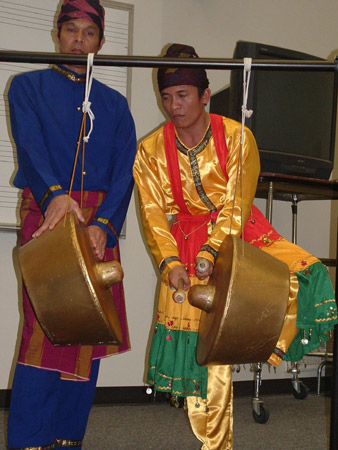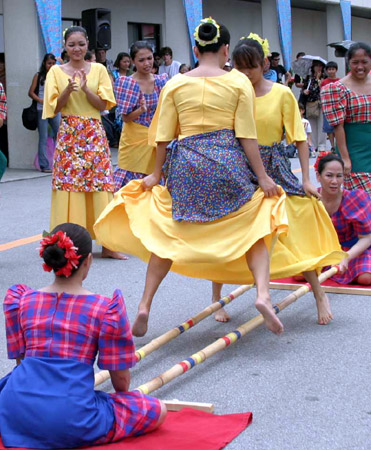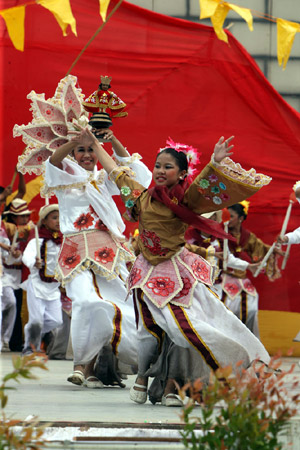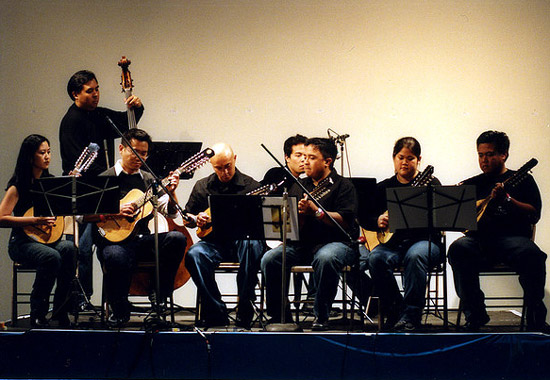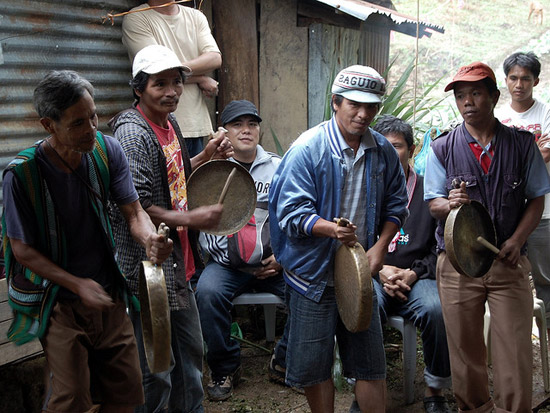Music: Traditional Forms
Gong Orchestras
The Philippines are part of the vast Southeast Asian gong music region, which stretches from Thailand south to Indonesia, north up to Laos and Cambodia, and east to the Philippines. Here the instrument that the rest of the orchestra and the music itself are built around is a set of tuned gongs.
In the Philippines two forms of gong are played, the kulintang and the gangsa. (There are many languages spoken in the Philippines, and each one has its own name for a gong orchestra. Kulintang and gangsa are used here as the most common.)
The gamelan of Indonesia is the form of Southeast Asian gong orchestra most familiar to Westerners. The kulintang of the Philippines derives from instruments like the Indonesian trompong—tapered bronze gongs with a boss (raised area in the center), arranged in a rack or frame. The kulintang is tuned to pentatonic and heptatonic scales like the Indonesian slendro and pelog scales (roughly, the same intervals as the black keys on a piano—slendro—and the white keys—pelog).
Gongs have a long history in the Philippines, and gongs of some sort may have come from China as early as the 3rd century CE. The bronze bossed gongs used in kulintang ensembles probably came in the 16th century from Sunda (West Java), in Indonesia.
In a kulintang performance, the kulintang itself carries the main melody. It is accompanied by five or six large and small hanging gongs, and at least one hand drum. Unlike Indonesian gamelan, where the music is built up of interlocking rhythmic and melodic units, kulintang music uses rhythmic and melodic modes as a basis for improvisation. Rhythmic patterns are assigned to each accompanying instrument. The kulintang player elaborates the basic melodic material, and keys the other players as to tempo and rhythmic pattern changes.
Kulintang music developed out of signaling between tribes. Gongs were tuned to the pitch levels of tribal languages, and could “speak” messages across great distances. The music is now mostly used for entertainment, played at social occasions and village ceremonies and festivals.
In some areas an older function of kulintang music is still found: Called tagonggo, this form is used to accompany healing dances. Beliefs going back to the old animist practices persist, and the gong instruments are believed to be inhabited by spirits. As in Indonesia, kulintang instruments cannot be stepped over, for fear of insulting their resident spirits.
Vocal Music
Though there are eight main languages and a host of dialects in the Philippine islands, folk tunes are often shared between linguistic groups. Song categories are widely shared as well. There are songs to observe rites of passage such as birth, death, and marriage; songs to accompany work in the fields; boating songs, lullabies, healing songs, war songs, and love songs. Songs are sung as part of community celebrations, religious ritual, and as pure entertainment. There are songs for success and songs for counting, songs to the dead; there are songs for sadness, and songs for “general merrymaking.” The oldest songs you can hear are no doubt the two-note chants sung by some of the more remote tribes in the Cordillera (northern mountain range).
The long occupation of the Philippines by the Spanish had a major influence on the folk song repertoire, and Spanish forms such as the serenade were adapted and made over by Philippine musicians.
Love Songs
One category of song found everywhere is the love song, and an enduringly popular style is the kundiman. The structure of the kundiman was strongly influenced by Spanish music, but the lyrics are most often in Tagalog.
The kundiman is a musical form, not just a category. It is always in triple time. The first part of the song is in a minor key; the second part in a major key. Each stanza of a traditional kundiman in Tagalog usually has 12 syllables. This form is followed in the most ancient love songs and in the latest ballad kundiman.
Tagalog composers in the 19th century used the kundiman form to write art songs. Filipino patriots sang kundiman in which the beloved became a symbolic representation of Filipino nationhood. The most famous of these was “Jocelynang Baliwag,” which became the anthem of the revolutionaries during the Philippine rebellion of 1896.
The term kundiman has been expanded until it now refers to any slow love song (much as the English term “ballad” has been broadened in popular music usage). But many modern kundiman, like those by Ruben Tagalog, though orchestrated with lush strings and lounge piano, nevertheless follow the traditional format.
Dance Music
Filipino folk dance falls into three main categories: indigenous dance, dances brought in by the Spanish, and creole dances—that is, dances from other countries that have been adapted to Filipino style.
The Bayanihan Philippine National Folk Dance Company (bayanihan means “for love of country”) and the Bayanihan Dance Theatre have brought many Filipino folk dances to the rest of the world. They present not only dance performances but also a narrative of Filipino culture and history.
A famous folk dance is the tinikling, in which dancers manipulate two or more long bamboo poles, moving them apart and together while other dancers step in and out of the openings. This is supposedly based on the bamboo traps set for the tikling, a long-legged bird that raids rice paddies. The art of the tinikling dancer lies in the grace and rapidity with which she avoids being trapped by the clashing bamboo poles. The poles also emphasize the beat of the dance, and are used as percussion as well.
Pangalay is a dance found among the Tausug people of the southern Philippines. Female dancers perform it wearing long brass “fingernails” that emphasize subtle hand movements. A version of the dance performed by male dancers substitutes martial arts movements for the hand motions of the female dancers. Another variant is called pamansak: in it two male dancers support a pair of stout bamboo poles while the female dancer dances on them.
Many Philippine peoples have a repertoire of epic song and chant relating heroic exploits, both from the tribal past and drawn from legends brought in from other countries. The singkil dance, originally danced to one of these epic chants, tells a story from the Hindu epic the Ramayana.
Sinulog Festival
Every year on the third Sunday in January, Cebu City celebrates the Santo Niño (Christ child) with a day of wild street dancing to gong orchestras and drumming. The festival draws its energy both from the island’s animist past and from its 300 years of Roman Catholicism. The festival has drawn an increasing number of tourists, and now dance competitions are held in a local sports arena to accommodate the influx of dancers and spectators.
Songs and Dances of the Spanish
Serenades
The harana is a style of singing to guitar accompaniment, traditionally sung when courting. The form derives from the Spanish serenade, and was popular until fairly recently. The guitarist Florante Aguilar has done much to revive interest in the harana, visiting older players to learn their songs and style. His reworking of old harana songs into pieces for classical guitar have given a new life to a form of music that had nearly died out.
String Orchestra
The rondalla is a string orchestra. It can number as few as four and as many as 30 or more instruments. The instruments themselves are derived from Spanish guitars and mandolins, but have evolved specifically Filipino forms. The repertoire of the rondalla is mostly Spanish dance music or Filipino folk song melodies.
Musical Theater
The zarzuela is a kind of Spanish musical theater, with singing and dancing. Important for introducing songs and dances into Filipino culture, the zarzuela helped spread Spanish couple dances like the pasadoble, the pandanggo, the valse, the chotis, and the mazurka.
After-Work Parties
Barrios fiestas are the after-work parties of Filipino farmers, times for entertainment and relaxation after a hard day in the fields. The dances at these fiestas are drawn from the Spanish repertoire, and include the jota, the fandango, and the valse, but they have been mixed with native dance forms and movements. There are dances in which women dance with glasses of water balanced on head and hands, dances that imitate the movements of harvesting or fishing, and courting dances with elaborate use of fans and handkerchiefs.
Spanish Ballroom
The Filipinos enthusiastically took up Spanish ballroom dances. The Maria Clara suite of dances, named after the heroine of Jose Rizal’s novel Noli Me Tangere, are courting dances and flirting dances that make use of props like fans, handkerchiefs, and tambourines. The Cariñosa, (Beloved), for example, based on the pandanggo (Filipino variant of the fandango), tells the story of a courtship, with the female dancer playing hide and seek behind a fan and a handkerchief.
Cordillera
The Cordillera of the northern Phillipines is home to the Kalinga, Ifugao, Bontoc, Benuet, Apayo, and other tribes. The other gong music of the Philippines, gangsa, is found here. Gangsa instruments are not related to the Indonesian instruments of the same name, which have metal bars laid over a wooden trough; Philippine gangsa are flat gongs suspended from strings or held in the hand.
As with the kulintang, gangsa gongs are believed to have a strong connection to the spirit world, and have traditionally been used to summon spirits, heal sickness, and bring good luck.
The Kalinga have two styles of gangsa playing: pattung, in which the gongs are held by the player and struck with mallets, and toppaya, in which the gongs are cradled in the player’s lap and struck with the hand. In some dances, such as the tachok, male dancers each hold a gong, accompanying themselves as they dance, while female dancers imitate the movements of birds.
Every tribe in the Cordillera has its own dances, danced for entertainment, to celebrate marriages, to heal sickness, and to celebrate victory in war. In the balangbang dance, for instance, Bontoc dancers celebrate the return of victorious headhunters.
Article written for World Trade Press by Marc Lecard.
Copyright © 1993—2025 World Trade Press. All rights reserved.

 Philippines
Philippines 